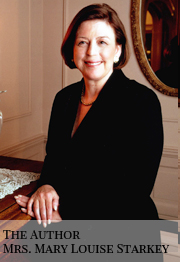Preface Preface
Introduction Introduction
Chapter 1 The Relationship of Service Page 1-32
Chapter 2 Private Service Household Etiquette Page 33-58
How we look
How we speak
How we handle ourselves
What we say and do
Chapter 3 Starkey Cleaning Philosophy Page 59-66
Chapter 4 Housekeeping Definition of Terms Page 67-72
Chapter 5 Housekeeping Baselines and Variables Page 73-76
Chapter 6 Principals’ Favorites and Standards Page 77-82
Chapter 7 What You Need To Know About Page 83-110
Chemicals, Tools & Personal Safety
Chapter 8 The Housekeeping Plan Page 111-130
Daily Graces
Zoning
Task Sheets and Day in the Life
Daily Housekeeping
Weekly Housekeeping
Detail Housekeeping
Project Housekeeping
Seasonal Housekeeping
Chapter 9 Dusting and Care of Wood Page 131-140
Chapter 10 Indoor Environments and Allergies Page 141-148
Chapter 11 Caring for Floors, Carpets & Oriental Rugs Page 149-164
Chapter 12 Care of Fine Art, Books, Antiques and Page 165-174
Collectibles
Chapter 13 Silver, Glass, Crystal and China Care Page 175-188
Chapter 14 Care of Chandeliers and Windows Page 189-196
Chapter 15 Bathroom Cleaning Page 197-206
Chapter 16 Bedroom Cleaning, Bed Making Page 207-218
& Turndown
Chapter 17 Kitchen Cleaning Page 219-228
Chapter 18 House Beautiful and Overall Tips Page 229-238
Appendix A About Mrs. Starkey
Appendix B Glossary
Appendix C Housekeeping Forms
Appendix D Housekeeping Toolbox
Excerpts from Starkey International “The Original Guide to Private Service”
Copyright 2008 Mansion Publishing, Inc.
Excerpts from Starkey International “The Original Guide to Private Service”
Copyright 2008 Mansion Publishing, Inc.
INTRODUCTION
HOUSEKEEPING STANDARDS
Introduction to Housekeeping
Excerpts from Starkey International “The Original Guide to Private Service”
Copyright 2008 Mansion Publishing, Inc.
Housekeeping
The art of cleaning and organization within the home
Cleaning: “Removing all dirt from the home environment”
According to the National Trust Manual of Housekeeping, references to Housekeeping
were recorded in the Oxford English Dictionary in 1538 and later defined as “The
Maintenance of the Household’’. By 1550, housekeeping was referred to as “The
Management of Household Affairs’’.
In the 1600s, literary evidence was recorded through inventories, wills and special written
instructions pertaining to care for clothing and furnishings.
In the 17th century, paintings revealed housemaids at work. Published manuals starting as
early as 1594, such as The Jewel House of Art and Nature by Sir Hugh Platt and those
published through the years, including Home Comforts by Cheryl Mendelson and The
Original Guide to Private Service Management by Mrs. Mary Louise Starkey, continue
highlighting Housekeeping as an art.
Other evidence of Housekeeping was recorded through house records, letters, notes,
memorandums, oral history and Housekeeping staff.
Housekeeping staff is recorded as early as the 16th century. Women and servants were
responsible for the rearing of children and general household management. China’s
counterparts to these important works were often called their äiyi. In the early 18th
century, the number of staff varied with the prosperity and social position of the master of
the house. In the 1900s, housecleaning companies were created to support women who
had gone to work to bring additional money into the household. These teams of cleaners
such as Merry Maids are still performing the majority of cleaning in the western world.
In China, the National Housekeeping Association consists of over 500,000 member
companies.
